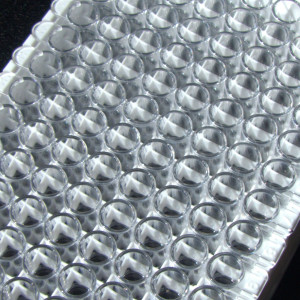Clean Sterilize and Functionalize PCR Microplates with Intrface Technologies atmospheric plasma systems. Microplates are also referred microwell plate or multiwell plates. PCR refers to the polymerase chain reaction method of DNA amplification. OEM PCR plate (eg microplate) manufacturers and end users utilize atmospheric plasma technology to modify the PCR well surface chemistry and create specific chemical groups. These groups can remain functional for up to 1 year when properly managed in an inert environment which meets common shelf life requirements. Functionalized microplates for immobilizing covalently biomolecules in ELISA type assays. Amine reactive microplates are for the immobilization of macromolecules or haptens containing free amine group. Amine functionalized microplates are for the immobilization of macromolecules or haptens containing free carboxyl group. Carboxyl functionalized microplates are for the immobilization of macromolecules or haptens containing free amino group.
Microplates treated with atmospheric plasma are sterile and functionalized to promote cell attachment and growth. Atmospheric plasma treated microplates are otherwise referred to as tissue culture treated. This tissue culture treatment process involves plasma treating polystyrene microplates in order to modify the hydrophobic plastic surface to make it more hydrophilic. The resulting functionalized microplate well surface carries a net negative charge due to the presence of oxygen-containing functional groups such as hydroxyl and carboxyl.
Microplate end users can now clean, sterilize, activate and functionalize PCR wells with our cost effective in-line atmospheric plasma systems to ensure proper drop volume, placement within the well improving overall diagnostic accuracy and yield. Atmospheric plasma treated microplates ensure strong adherence of cells to the microplate wells. Lab users can now wash and sterilize immunoassays in-house with economical precision with Intrface Technologies atmospheric plasma systems. We offer several different source nozzle configurations designed to the exact pitch of common PCR configurations allowing you to treat your microplates in-line.
Intrface Technologies atmospheric plasma treatment of PCR microplates offers a clean, safe and non-contact surface preparation method the maximize performance, repeatability and cost saving of cell assays and DNA analysis with microplate applications. Contact us to discuss your composite bonding application needs.
Related articles:
- North SH, Lock EH, Cooper CJ, Franek JB, Taitt CR, Walton SG., “Plasma-based surface modification of polystyrene microtiter plates for covalent immobilization of biomolecules.” ACS Appl Mater Interfaces. 2010 Oct;2(10):2884-91.Abstract: In recent years, polymer surfaces have become increasingly popular for biomolecule attachment because of their relatively low cost and desirable bulk physicochemical characteristics. However, the chemical inertness of some polymer surfaces poses an obstacle to more expansive implementation of polymer materials in bioanalytical applications. We describe use of argon plasma to generate reactive hydroxyl moieties at the surface of polystyrene microtiter plates. The plates are then selectively functionalized with silanes and cross-linkers suitable for the covalent immobilization of biomolecules. This plasma-based method for microtiter plate functionalization was evaluated after each step by X-ray photoelectron spectroscopy, water contact angle analysis, atomic force microscopy, and bioimmobilization efficacy. We further demonstrate that the plasma treatment followed by silane derivatization supports direct, covalent immobilization of biomolecules on microtiter plates and thus overcomes challenging issues typically associated with simple physisorption. Importantly, biomolecules covalently immobilized onto microtiter plates using this plasma-based method retained functionality and demonstrated attachment efficiency comparable to commercial preactivated microtiter plates.
- S. H. North, E. H. Lock, C. J. Cooper, J. B. Franek, C. R. Taitt, and S.G. Walton., “Plasma-Based Surface Modification of Polystyrene Microtiter Plates for Covalent Immobilization of Biomolecules,” ACS Appl. Mater. Interfaces, 2010, 2 (10), pp 2884–2891. Abstract: In recent years, polymer surfaces have become increasingly popular for biomolecule attachment because of their relatively low cost and desirable bulk physicochemical characteristics. However, the chemical inertness of some polymer surfaces poses an obstacle to more expansive implementation of polymer materials in bioanalytical applications. We describe use of argon plasma to generate reactive hydroxyl moieties at the surface of polystyrene microtiter plates. The plates are then selectively functionalized with silanes and cross-linkers suitable for the covalent immobilization of biomolecules. This plasma-based method for microtiter plate functionalization was evaluated after each step by X-ray photoelectron spectroscopy, water contact angle analysis, atomic force microscopy, and bioimmobilization efficacy. We further demonstrate that the plasma treatment followed by silane derivatization supports direct, covalent immobilization of biomolecules on microtiter plates and thus overcomes challenging issues typically associated with simple physisorption. Importantly, biomolecules covalently immobilized onto microtiter plates using this plasma-based method retained functionality and demonstrated attachment efficiency comparable to commercial preactivated microtiter plates.
- Toshifuji, J., Katsumata, T., Takikawa, H., Sakakibara, T., and Shimizu, I., “Cold arc-plasma jet under atmospheric pressure for surface modification,” Surf. Coat. Technol. 171, 302 (2003). Abstract: A relatively cold arc-plasma jet under atmospheric pressure was developed using a pulse power supply, called a Plasma Energized (PEN)-Jet. A needle electrode was placed in a glass tube, and a cap electrode with a center-hole (3 mm diameter) was placed at the tube end. The electric arc was discharged between the electrodes by applying intermittent bipolar pulse power. By introducing dry air, nitrogen, or oxygen gas into the tube from the other end, the plasma gas of the arc was spewed out from the center-holed cap electrode, and a plasma jet was formed. The length and temperature of this plasma jet was measured as a function of pulse frequency (10–30 kHz). Both were found to increase with the increase in pulse frequency, not being very dependent on the type of gas under present experimental conditions. Maximum jet length was approximately 15 mm at 30 kHz, and maximum temperature at 5 mm from the cap electrode was 250 8C. Various metals and polymers were treated by PEN-Jet. The water contact-angle of these materials was found to decrease.
Contact us to find out more about the Atmospheric Plasma Treatment to clean sterilize and functionalize microplates or to receive a complimentary copy of the technical articles above utilizing atmospheric plasma. Please reference the authors and publication number in your email request (copy and paste into your email response).


